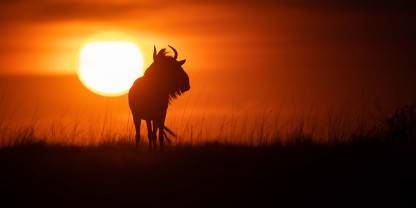Average Expert Rating
Rating Breakdown
Write a User ReviewAfrica’s unknown wildebeest migration
Liuwa Plain doesn’t have a huge variety of wildlife. There
Read more
are no elephants or giraffes, for example. But it’s the quality of the sightings, the remote tranquility and the magnificent setting that makes this place so special for me.Gorgeous but remote park in Zambia’s wild west
Tucked away in one of Zambia’s remotest corners, close to the Angolan border, Liuwa Plain attracts few tourists, but that’s not for lack of interest. Those hardy travellers that make the trek can expect to enjoy the thrill of a true wilderness experience. Get the timing right, and you can see almost as many wildebeest on the move here as you would in the Serengeti at the height of the migration. Their numbers peak in November and December. Other significan t species are gradually being introduced.
Another good reason to time things carefully is that road access to the park is via the Barotse floodplain – tough going in the dry season, with yawning potholes, and impossible after rain. I certainly wouldn’t recommend it to anyone who doesn’t enjoy long, bumpy journeys by 4WD.
Zambia’s Wild West
Despite its relative lack of big game, Liuwa Plain National Park is one of my favourites. It’s a paradise for the true bush-lover – even just getting into the park is an adventure that includes negotiating a river on a small and rickety hand-pulled ferry just about big enough for a solitary vehicle.
Liuwa has become known for the second largest wildebeest migration in Africa, which usually begins in October or November. The seemingly endless plains make for a striking backdrop to this spectacle, and all those wildebeest calves are a little like a walking buffet for the park’s hyena and lion.
The camps here are as basic and remote as you’ll find anywhere, but there’s lots of peace and quiet and authentic bush charm. An added point of interest in Liuwa is the scattering of small villages, and the inhabitants who continue to practice their traditional subsistence farming, within the park boundaries. When I was last here, the local villagers were the only other people we saw in 4 days inside the park – and not a single other vehicle.
Africa’s second-largest wildebeest migration
The main wildlife highlight of Liuwa is Africa's second-largest wildebeest migration. Nobody seems sure exactly how many wildebeest there are (estimates range from 35,000 to more than 50,000), but if you visit at the right time of year – optimally from late October into January, which is also calving season – you can expect to see herds of several thousand kicking up sand and baaing like disgruntled sheep as they sweep across the plains.
We enjoyed some excellent predator viewing in Liuwa. Lion sightings included one of the most handsome males I have ever encountered,
Read more
as well as a small pride feeding on a fresh kill. Although Liuwa has something of a reputation for good cheetah sightings, we only saw one individual over the course of our six-day stay, and it was very skittish. We also encountered caracal (once) and side-striped jackal (daily). The park supports around 500 spotted hyenas, and because they are unusually habituated, we were able to spend many hours parked at different hyena dens, enjoying the interaction between these highly sociable carnivores.The bird watching in Liuwa is absolutely outstanding. It’s the best place in Zambia to see several marsh and grassland species, notably wattled crane, grey crowned crane, secretary bird, Denham’s bustard, rosy-throated longclaw and long-tailed widowbird. The open pans are good for lapwings, plovers, sandpipers and other shorebirds, while flotillas of pelicans forage on the open water, and slaty egret, rufous-bellied heron and greater painted-snipe might be seen in the fringing vegetation. The undoubted avian highlight of Liuwa, however, are the mesmerizing flocks of several thousand near-threatened black-winged pratincole that swarm cloud-like above the plains.
Despite its wilderness feel and high densities of certain species, Liuwa is not much of a Big Five reserve. Leopards and rhinos are absent altogether, elephants are occasional visitors, and we saw buffaloes only once during our visit (admittedly a fabulous sighting of a hundred-strong herd drinking at a pan). Other notable absentees include giraffe and hippo, and while the wildebeest herds are often accompanied by plains zebra and red lechwe, the only other antelopes that could be considered common are the twitchy oribi and gray duiker.
To me, Liuwa Plain was an absolute highlight of Zambia, not least because of the sense of space associated with its wide-open plains and immense skies. But the lack of mammalian variety makes it quite a niche destination, and it’s questionable whether it would be suited to a first-time safari-goer.
Migration Mania
Liuwa Plain in western Zambia is the answer for safari goers who’ve dreamt of seeing tens of thousands of wildebeest migrating across the wide-open plains without another vehicle or person in sight. If you’ve ever sat in the Masai Mara surrounded by minibuses and tried to imagine what the incredible spectacle was like fifty years earlier, before the tourist hordes arrived, then Liuwa is the place for you. But migrating wildebeest and zebra aren’t the only reason to visit the true wilderness of Liuwa, huge clans of hyaena, cheetah and lion roam the savanna and surrounding woodlands, preying on the sick and the weak. The plains are in fact a giant wetland – inaccessible during the rains but teeming with water birds, colourful flowers and wildlife thereafter. Liuwa is my recommendation for tourists wanting to experience great wildlife-viewing in one of Africa’s wildest wilderness areas.

